Catholicism
About Andrew Cusack
 Writer, web designer, etc.; born in New York; educated in Argentina, Scotland, and South Africa; now based in London.
Writer, web designer, etc.; born in New York; educated in Argentina, Scotland, and South Africa; now based in London. read more
News
Blogs
Reviews & Periodicals
Arts & Design
World
France
Mitteleuropa
Knickerbockers
Argentina
The Levant
Africa
Cape of Good Hope
Netherlands
Scandinavia
Québec
India
Muscovy
Germany
Academica
Clarity on Torture
Those who see abortion as an evil are often frustrated by those who attempt to justify abortion by vague arguments about “choice” or even more practical arguments about exceptions for rape or incest, or the health of the mother. But many of these same people lose their moral clarity when the subject is torture. Suddenly they are the ones bringing up exceptions and parsing definitions.
There is so much confusion over this issue that in a recent TV interview, a prominent Catholic journalist let a former Bush Administration speechwriter, also a Catholic, grossly misrepresent Catholic teaching in a shameful apologia for torture.
Let us re-establish clarity. Torture, whether physical or psychological, is a barbaric, savage act, not justifiable under any circumstances, and unworthy of a civilized society.
But don’t take our word for it. For those readers who are religious, the Evangelical Lutheran Church in America began calling for America to cease torturing prisoners more than a year ago. American Episcopal bishops agree, as do other Protestant denominations. For our Catholic readers, Pope Benedict XVI wrote, “I reiterate that the prohibition against torture cannot be contravened under any circumstances.” The Catholic Church draws no distinction between physical and psychological torture.
For those readers who aren’t religious, we turn to U.S. law and international law, where torture is, without exception, condemned. Not one state or municipal law enforcement agency permits it. The Army Field Manual, which regulates interrogations by the U.S. military, prohibits torture. So does the Geneva Convention—a treaty to which both the Holy See and the United States are signatories. None of these institutions or documents draws any distinction between physical and psychological torture either. For all, torture is torture.
When Catholics and Protestants agree, and when religious and secular institutions agree, that torture is an offense against human dignity and that those guilty of it should be thrown in jail, may we not agree that perhaps it is immoral? Do we really need to get into the nuts and bolts of what constitutes torture?
Yes, we do. Most will agree that taking a power drill to a man’s shoulder or pulling out his fingernails with pliers for punishment or to extract information is torture. But when the subject is waterboarding, clarity vanishes again. Some consider waterboarding to be mere psychological torture—which, as we’ve already established, is morally indistinguishable from physical torture.
But waterboarding is not a harmless dunk in the tub, as former Vice President Dick Cheney once likened it, and it is not psychological torture. In waterboarding, a subject is strapped to a gurney. His feet are elevated slightly above his head. A cloth is draped over his face. And water is poured on his face so that it enters his nose and mouth and flows into his lungs. CIA interrogators are instructed to pour the water immediately after a detainee exhales, to ensure he inhales water, not air. They use their hands to “dam the flow” of excess water from a detainee’s mouth. And detainees who are scheduled for waterboarding are put on a liquid diet, to minimize the risk of death should they inhale their own vomit.
This procedure became official American policy in our so-called War on Terror, but it was not always so. Waterboarding has been condemned by the United States government since at least 1898, when American soldiers were court marshaled for waterboarding prisoners during our occupation of the Philippines following the Spanish-American War. In World War II, we hanged Japanese war criminals for waterboarding American and Allied troops. In the 1980s in Texas, a sheriff and three of his deputies were convicted by the Justice Department for waterboarding prisoners to extract confessions.
And yet, there are those exceptions: American security is at stake. If waterboarding saves even one life, isn’t it worth it?
If torturing a terrorist suspect saved a city from destruction, or if it saved even one life, it would still be a barbaric, savage act, unworthy of a civilized society. If expediency were enough to justify an immoral act, then abortion would be justifiable.
G.K. Chesterton wrote in 1916 that people who purport to defend civilization against barbarians undermine their cause when they resort to barbaric tactics. “The more we insist that the terms must be our terms, the more do we weaken ourselves if the methods are their methods.”
During World War I, when some in England demanded that German soldiers captured on English soil be denied humane treatment, Chesterton countered, “Such small revenges are unworthy of the dignity of indignation. They are also futile and inconsequent.”
Our whole hope of getting a monster killed and not scotched depends upon our keeping fresh the original human horror at its monstrosity. It may be illogical, but it will certainly be natural, if that horror is somewhat dulled if, by the end of the war, everybody seems to be fighting with pretty much the same weapons.
When you torture, you turn the victim into a hero, for there is more honor in defying a torturer than in being a torturer.
“A kind of courage can exist in a merciless and unmagnaminous soldier, as it can exist in a merciless and unmagnaminous wild pig,” Chesterton wrote. “But it does not happen to be the kind of courage that our brethren have died to keep alive.”
Reese Still Doesn’t Get It
“Reform movements need an enemy to organize against,” Fr. Thomas Reese, the former editor of America magazine tells TIME (which I stumbled upon at Conservative Blog for Peace). “As most bishops have gotten their acts together on sex abuse, they have looked less like the enemy and more like part of the solution. Enthusiasm for reform declined. With the Pope’s forthright response, it will decline even more.”
Bishops “getting their acts together” is reform! But of course, Fr. Reese is using the word “reform” in an Orwellian manner, meaning not reform, but in fact revolt. His use would be disingenuous, except that I suspect Fr. Reese has actually convinced himself it is appropriate: as the saying goes, “never attribute to malice that which can be adequately explained by …” well, let’s remain charitable and say “credulity”.
As bishops institute genuine reform, the sympathy — never more than limited — for progressive change-for-change’s sake unsurprisingly disappears except among the old die-hards like Fr. Reese. Enthusiasm for reform — genuine reform that is — only grows, especially in those places where it has been implemented, in accordance with the Pope’s clearly stated desires. If he is anything, Benedict XVI is a pope of reform, of putting the house back in order.
One almost feels a tinge of pity for the Fr. Reeses of this world as their hopes and dreams slip further and further away, but then one remembers it is entirely their own fault. He who marries himself to the Spirit of the Age is soon widowed. Attach yourself to the permanent things and you will never end up like poor Fr. Reese.
“The Reality is Love”
“The doom and gloom conveyed by the media is not the full picture.”
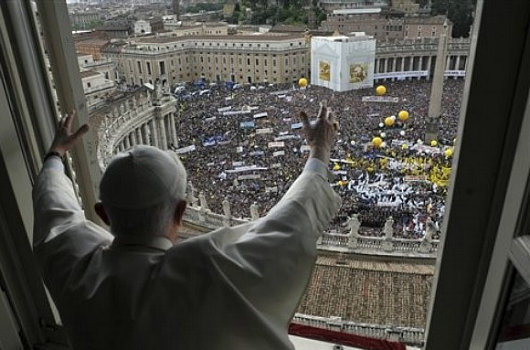
by HILARY WHITE
ROME, May 17, 2010 (LifeSiteNews.com) – There is one thing that still surprises me about Italy: the Italians love the pope. Even when they don’t necessarily listen to or obey him on every point, even when he is not an Italian, the Italians have a genuine and very warm paternal relationship with the holder of the Keys. This Sunday, 150,000 people packed into St. Peter’s Piazza to hear Benedict XVI give an address after reciting the Regina Caeli, and to show their Holy Father their love and support after the trying period of the last few months.
I suppose coming from the Anglo world, imbued with its perpetually simmering anti-Catholicism inherited from the Elizabethans and the Glorious Revolution, it will always come as a pleasant surprise to see that, whatever vitriol the mainstream media of the anglosphere continues to pour onto this papacy, that vitriol is not the reality. Whatever Reuters or the New York Times or even Ansa will tell you, the crowd of over 150,000 people gathered in St. Peter’s Piazza on Sunday were nearly beside themselves with joy to see their Papa.
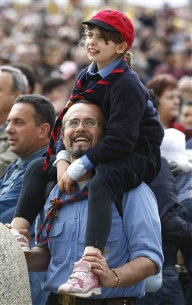 It has been unseasonably cold and raining more or less steadily for weeks, and being still something of a newbie around here, I had not expected to have to hurry on Sunday. Still thinking like an Anglo and not expecting the Italian enthusiasm for their pope, I had planned to make my way over to St. Peter’s Piazza about 11:30, and thought I could take a leisurely 9:30 train into the City and take the bus down to the Campo di Fiori to have a sandwich and a cup of awful Roman tea first. But in the café a television was playing live coverage of the Piazza and I could see the crowd was already, at 10:45, starting to fill the huge space. I took my panino di pollo to go.
It has been unseasonably cold and raining more or less steadily for weeks, and being still something of a newbie around here, I had not expected to have to hurry on Sunday. Still thinking like an Anglo and not expecting the Italian enthusiasm for their pope, I had planned to make my way over to St. Peter’s Piazza about 11:30, and thought I could take a leisurely 9:30 train into the City and take the bus down to the Campo di Fiori to have a sandwich and a cup of awful Roman tea first. But in the café a television was playing live coverage of the Piazza and I could see the crowd was already, at 10:45, starting to fill the huge space. I took my panino di pollo to go.
I had read that the Piazza could hold about 100,000 people, and remembered the day a couple of years ago when the Italians gathered to give a collective two-fingers-up to Rome’s heavily secularist Sapienza University, who had insulted their Holy Father by rescinding his invitation to speak. The English-language press was most reluctant to report that thousands of happy, shouting, smiling Sapienza students filled the square at the General Audience that week.
Today they are admitting that the Piazza held over 150,000 on Sunday, called together from all over Italy by a coalition of Italian lay associations – and that seems about right. What they don’t seem to want to report is the spell of joy that held them, many of whom waited for hours to see and hear and shout cheers to the pope. (more…)
Nuns!
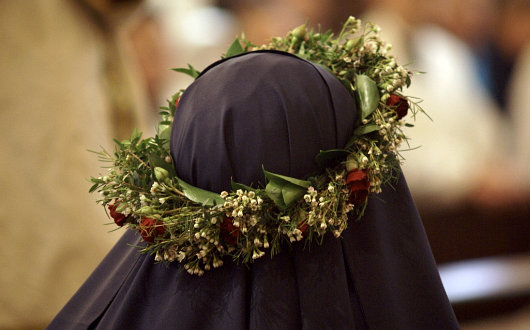
The author of Kansas Catholic was gracious enough to provide his readers with numerous photos of the recent profession of vows of the Benedictines of Mary, Queen of the Apostles that took place recently at Old St. Patrick’s in Kansas City, Mo. The Benedictines of Mary, Queen of the Apostles are a “traditional monastic community of women who desire to imitate the Blessed Virgin Mary in the giving of herself to God to fulfill His Will, especially in her role of assistance by prayer and work to the Apostles, first priests of the Catholic Church”.
Founded fifteen years ago in Pennsylvania, they accepted the invitation of the Most Rev. Robert W. Finn, the Bishop of Kansas City-St. Joseph, to move to his diocese in 2006. You can find out more about this relatively young community at their website here. (more…)
It helps to be a 92-year-old D-Day veteran
Daniel Hannan, the whiggish MEP representing South East England, relays a story about His Excellency Philip Hannan, the 92-year-old former Archbishop of New Orleans:
When Hurricane Katrina wrecked the city, the old prelate went to the diocesan office to help. He found his successor wracked with concern about the fate of a parish priest who was lost in the storm. Seeing that anxiety had left the poor man paralysed, my 92-year-old kinsman called the military authorities.
“This is Phil Hannan. I jumped with the 82nd Airborne at Normandy. I need a helicopter”.
A helicopter duly arrived, and carried the former army padre to the home of the missing cleric, which had been turned to matchwood. Returning to the archiepiscopal residence, Hannan announced without ceremony, “He’s dead, may he rest in peace. Let’s move on to the next problem”.
Dabbling in Freemasonry at Downside
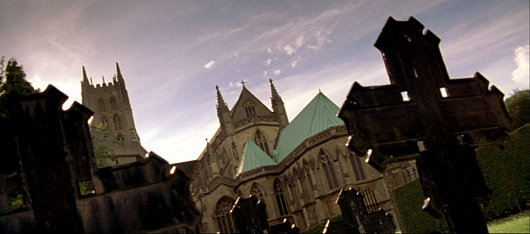
One of Britain’s most prominent Catholic schools, Downside Abbey in Somerset, has a friendship with Freemasonry that Catholics might find rather troubling. As recently brought to light in a report on the Curated Secrets blog, Downside invited “Spenny” Compton, 7th Marquess of Northampton (as well as Britain’s wealthiest Buddhist and sometime Pro-Grand Master of the United Grand Lodge of England) to talk about Freemasonry to students at the Benedictine boarding school. “I was invited two years ago to address some of the senior boys and monks at Downside, the Roman Catholic boarding school,” the Marquess wrote in 2005. (more…)
“There is no Generation Benedict”
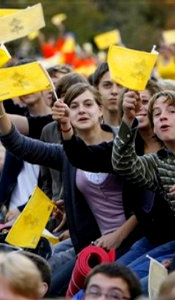 So claims Germany’s Catholic youth leader Dirk Tänzler, who is ‘reserved’ & ‘ambivalent’ about the Pope. Is Tänzler right?
So claims Germany’s Catholic youth leader Dirk Tänzler, who is ‘reserved’ & ‘ambivalent’ about the Pope. Is Tänzler right?
AMIDST THE MEDIA’S attempts to sling mud at Pope Benedict XVI, one of the most prominent Catholic youth leaders in Germany has chimed in with lackluster words about the reigning pontiff. Dirk Tänzler, the head of the BDKJ, the umbrella group of German Catholic youth organizations, gave an interview to Der Spiegel, the prominent weekly news magazine with a circulation of over one million. Asked his verdict of the so-far five years of Pope Benedict’s reign, Tänzler responded with the word “ambivalent”. Contrasting Benedict XVI with John Paul II — a “showmaster” — the BDKJ head said that, despite some good points, “a lot of young people often simply don’t understand him”. “Most have a different idea of how to live their lives than the pope might imagine for them. There is no ‘Generation Benedict.'”
But are Tänzler’s thoughts an accurate reflection of the state of Catholic youth in Germany or elsewhere? Over a million young people travelled to Cologne to experience World Youth Day with the new pontiff in 2005. (The following WYD held in Sydney in 2008, unfortunately offers little comparison given the relative isolation of Australia). Everywhere the Pope has travelled, such as to the Czech Republic last year, or France and the United States in 2008, vast multitudes of youth have greeted him, often waiting hours for the privilege. (more…)
Some Stocks Fall, Others Rise
In the first quarter of 2010, CNN’s flagship news anchors ratings dropped by fifty percent — half their entire viewership! The New York Times continues to slide towards bankruptcy and irrelevance (who wants to pay two dollars a day to be lied to?). Exhibiting a tremendous amount of cheek, the Times Company (which owns both the Times and the Boston Globe) threatened to shut the Boston Globe unless the staff agreed to $20 million in cuts. This year, the $20 million made by salary and benefits cuts across the board at the Globe were awarded in compensation to just two Times Company employees, Chairman Arthur Sulzberger and Chief Executive Janet L. Robinson. Meanwhile, the Company’s profits are collapsing along with its circulation and ad revenue, while its debt increases.
Not everyone’s stock is going down, however. Anna Arco reports a greater-than-usual surge in Mass attendance during Holy Week at the Stefansdom in Vienna, as well as at Westminster Cathedral and the Brompton Oratory in London.
The only advice one could dispense to CNN, the Times, et al. is the aphorism that he who marries the spirit of the age is soon widowed.
French Intellectuals Pen ‘Appeal to Truth’ In Support of Benedict XVI
A number of prominent French men & women have written a ‘call to truth’ supporting Pope Benedict XVI in the current media storm and pedophilia scandal. As the Appeal’s about page says, Pope Benedict XVI “is the first pope to address head-on, without compromise, the problem. Paradoxically, he is the subject of undermining and personal attacks, attacks relayed with a certain complacency on the part of the press”.
The list of original signatories includes writers, essayists, literary critics, bloggers, professors, philosophers, businessmen, senators, members of parliament, mayors, publishers, actors, a Protestant minister, a Fields medal winner, and even a sexologist.
The ‘Appel à la Vérité’ is reproduced, in an unofficial English translation, below:
The cases of pedophilia in the Church are, for all Catholics, a source of profound grief and great sorrow. From members of the Church hierarchy were, in some cases, serious deficiencies and failures, and we welcome the Pope’s wish to shed light on these cases.
With the bishops, and as members of the Church, lay Catholics bear the brunt of the crimes of certain priests and failures of their superiors; they fall firmly, as Christ taught, on the side of those who suffer most from these crimes, the victims, while praying for the culprits.
As for us, we hope with all our hearts that the whole truth comes out and all in the Catholic Church that could enable these offenses brought to Christ should be discussed calmly and amicably amongst all men and women of good will.
At the same time, we regret the runaway and provocative press that accompany these cases. Beyond the legitimate & democratic right to information, we can only note with sadness, as Christians but also as citizens, that many media in our country (and in the West in general) treat these cases with bias, ignorance, or delight. Shourtcuts in generalizations, the portrait of the Church which is currently done in the press does not match the experiences of Catholic Christians.
While reiterating our horror at the crime of pedophile priests and our solidarity with the victims, we urge the media to an ethic of responsibility that would undertake a more ethical treatment of these cases. The effects of runaway media are, by far, reserved to the Church, but we are tired of and battered by this thrashing. We think of so many priests who courageously, and sometimes in solitude, bear the message of Christ.
We are with them.
We welcome the letter from the bishops of France to Pope Benedict XVI, and wish to see the Catholic Church, with serenity and responsibility, through this painful ordeal.
This appeal was launched at the initiative of François Taillandier (writer), Frigide Barjot (humourist), Natalia Trouiller (journalist & blogger), Koz (blogger & lawyer), and Francis Miclo (philosopher).
Original signatories (31 March 2010):
Jacques Arènes (pyschoanalyst and writer)
Denis Badré (senator)
Frigide Barjot (humourist)
Jean-Marc Bastière (journalist and writer)
Claude Bébéar (honorary president of AXA)
Michel Boyancé (Dean of the Institut de France and comparative philosopher)
Rémi Brague (philosopher, member of the Institut de France)
Alexis Brézet (journalist)
Jean des Cars (writer)
François Cassingena-Trévedy (Benedictine monk, liturgist and writer)
Jean Chélini (historian, permanent secretary of the Académie de Marseille)
Ghislain du Chéné (international coordinator of Foi et Lumière)
Colette Combe (pscyhoanalyst and writer),
François Content (Director-General of the Fondation d’Auteuil)
Philippe Delaroche (writer, journalist)
Chantal Delsol (writer and philosopher)
Patrick Demouy (historian, university professor)
Bernadette Dupont (senator)
Bertrand d’Esparron (corporate communications manager)
Emmanuel Falque (philosophee and writer)
Olivier Florant (sexologist)
Jean-Christophe Fromantin (mayor of Neuilly-sur-Seine, businessman)
Réginald Gaillard (Editions de Corlevour)
Patrick de Gméline (historian)
Samuel Grzybowski (President/founder of the association Coexister)
Fabrice Hadjadj (essayist and playwright)
Rona Hartner (singer, actress)
François Huguenin (writer)
Vincent Hervouët (journalist)
Yvon Jacob (chief executive, former member of parliament)
Gaspard-Marie Janvier (writer)
Pasteur Alain Joly (Lutheran Church)
Patrick Kéchichian (writer and literary critic)
Koz (blogger and lawyer)
Louis-Etienne de Labarthe (editor-in-chief, Il est vivant)
Philippe de Lachapelle (director of the OCH)
Laurent Lafforgue (mathematician, winner of the Fields medal)
Gérard Leclerc (essayist, journalist)
Henrik Lindell (journalist)
Michael Lonsdale (actor)
Victor Loupan (editor, La Pensée Russe)
Jean-Baptiste Maillard (journalist, essayist)
Bruno Maillé (teacher, essayist)
François Maillot (Director-General, La Procure)
Jean-Luc Marion (philosopher, member of the Académie Française)
Jean-Pierre Marcon (member of parliament)
Nicolas Mathey (Professor of Law, Université de Paris V)
Jean-Pierre Machelon (Professor of Law, Université de Paris V)
Marc Mennessier (journalist)
François Miclo (philosopher)
Jean-Marc Nesme (member of parliament & mayor)
Philippe Oswald (journalist)
Xavier Patier (writer)
Patrice de Plunkett (writer and blogger)
Hugues Portelli (senator)
Jean-Frédéric Poisson (member of parliament)
Aymeric Pourbaix (journalist)
Guillaume de Prémare (communications consultant, Médias & Evangile)
Edmond Prochain (blogger, journalist)
Samuel Pruvot (journalist)
Jacques Rémiller (member of parliament & mayor)
Alina Reyes (writer)
Damien Ricour (actor)
Ivan Rioufol (essayist, journalist)
Catherine Rouvier (jurist, political scientist)
Jean Sévillia (journalist, writer)
Grégory Solari (editor)
Raphaël Stainville (journalist)
Denis Sureau (editor, theologian)
François Taillandier (writer)
Denis Tillinac (writer)
Henri Tincq (journalist and writer)
Hubert de Torcy (editor-in-chief, L’1visible)
Vincent Trémolet de Villers (journalist)
Natalia Trouiller (blogger, journalist)
Didier Truchet (Professor of Law, Université de Paris II)
Patrick Tudoret (writer)
Christian Vanneste (member of parliament)
François de Wendel (business executive)
The Passion of Pope Benedict: Six Accusations, One Question
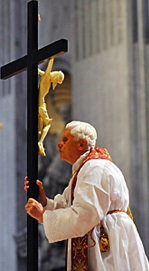 Pedophilia is only the latest weapon aimed against Joseph Ratzinger. And each time, he is attacked where he most exercises his leadership role. One by one, the critical points of this pontificate.
Pedophilia is only the latest weapon aimed against Joseph Ratzinger. And each time, he is attacked where he most exercises his leadership role. One by one, the critical points of this pontificate.
NOTE: For its combination of succinctness and clarity of thought, this piece by the most indispensable of Vatican-watchers, Sandro Magister of L’Espresso, deserves reproduction in full.
ROME, April 7, 2010 – The attack striking pope Joseph Ratzinger with the weapon of the scandal posed by priests of his Church is a constant of this pontificate.
It is a constant because every time, on different terrain, striking Benedict XVI means striking the very man who has worked and is working, on that same terrain, with the greatest foresight, resolve, and success. (more…)
“Lourdes”
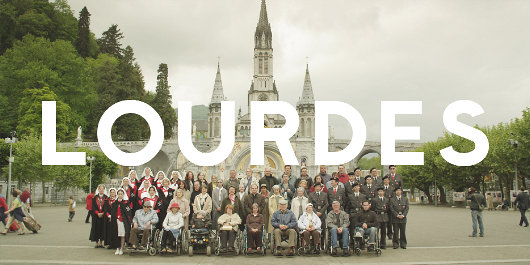
Various sources have brought to light the new film “Lourdes” by the Austrian director Jessica Hausner. The film depicts the pilgrimage to Lourdes of a non-particularly religious woman (played by Sylvie Testud) suffering from Mutiple Sclerosis who is healed of her illness. The film by a non-believing director has met with both praise and suspicion from Catholic quarters, and has been compared, at least stylistically, to the work of Michael Haneke (whose latest, “The White Ribbon” is currently showing in New York). Latest to weigh in is the Catholic Herald‘s indispensable Anna Arco, who writes:
I saw it as an exercise in theodicy where God loses. In a quiet dispassionate way, Jessica Hausner, the film’s Austrian director, paints a bleak picture of a world where fate is a blind, arbitrary force and human beings clutch at the straws of faith, half-truths in their cowardly despair. The suffering are not healed, human nature is selfish and the problem of pain is not solved. God can’t exist because he isn’t fair. Christianity offers a web of half-truths obscuring a nihilistic reality.
Miss Arco recently spoke with the director, and the interview will be published in the next Catholic Herald. (more…)
Alexander McCall Smith & the Sisters of Jaipur
The Scottish writer Alexander McCall Smith — noted for the fact that his books are actually a pleasure to read — pens a letter to readers every few months. In the latest letter, he mentions that he recently attended the Jaipur Literary Festival in Rajasthan’s famous “Pink City”:
But the visit to Jaipur was not all literary festival. My wife and I paid a visit to the Mother Theresa Home in the city, which was, as you can imagine, a very moving experience. Over two hundred residents, most of them with nowhere else to go, no possessions, and no money, are looked after by some seven sisters. These sisters are tireless – completely tireless – and give their lives over to the living care of these abandoned people.
At a time when the Catholic Church is coming under severe criticism for its failures (which have been, understandably, very much in the news), we should perhaps remember the extraordinary work of people such as the nuns of this community, who have done so much to bring love into the lives of those who have nothing and who would otherwise die alone and uncared for. I cannot tell you how moved I was by what I saw and by my conversation with the nuns.
An apposite reminder.
If you haven’t yet read Prof. McCall Smith’s 44 Scotland Street series, I suggest you float down to your nearest bookseller and purchase the first installation (handily titled 44 Scotland Street) today. They are a procession of delightful stories surrounding a number of fictional characters in an Edinburgh townhouse, and if you’re familiar with the capital city, you might just come a cross the occasional non-fictional friend interspersed amongst the creations of McCall Smith’s mind.
The Patriarchal Cathedral Basilica of Saint Mark the Evangelist, Venice
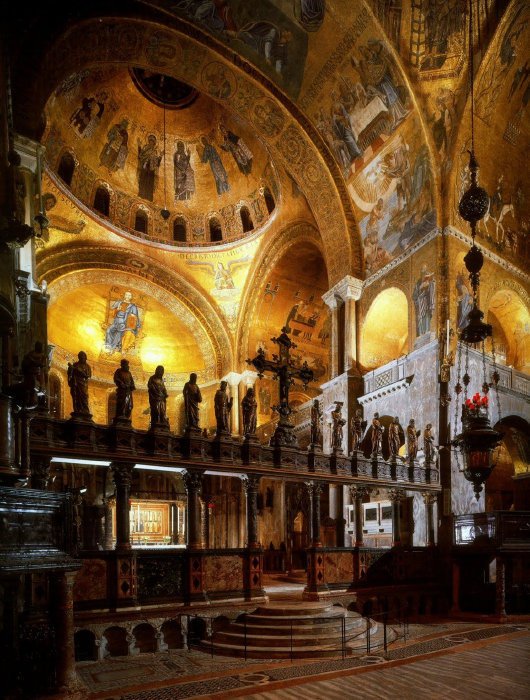
One of the readers over at the NLM sent in these photos of St. Mark’s Basilica in Venice. The reason why St. Mark’s is usually referred to as a mere basilica is because for centuries this was not the seat of the Patriarch of Venice. From the seventh century, the Church of San Pietro di Castello was the cathedral of Venice, while St. Mark’s was the house church of the Doge, the elected duke of the Venetian aristocratic republic. It was only in 1807 that St. Mark’s was made the cathedral of Venice, and San Pietro di Castello reduced to co-cathedral status. But by the time St. Mark’s became a cathedral, everyone had already become accustomed to referring to it as “St. Mark’s Basilica”. (more…)
When an American aristocrat meets a European Grand Duke
Mother Margaret Georgina Patton, OSB of Regina Laudis Abbey in New England is the daughter of Gen. George S. Patton IV and granddaughter of the famous Gen. George S. Patton III. Mother Patton remembers being introduced to the Grand Duke of Luxembourg when she was but five years of age. At the instruction of her parents, she spent a week practicing her curtsey. When the moment finally came and she was brought before His Royal Highness, she looked him over, and stuck out her hand. The young girl had expected a crown, and, seeing none, thought a regular old handshake would do.
The elder Gen. Patton did have a connection to the Abbey himself. “General George Patton, Sr., liberated France as the commanding general of the Third Army,” explains Mother Delores Hart (the former film actress, and only nun among the members of the Academy of Motion Picture Arts & Sciences). “His was the army that liberated Jouarre, the abbey where Mother Benedict was in hiding.” Mother Benedict Duss founded the Abbey of Regina Laudis after the war, and died at the ripe age of 94.
“This connection continues through the whole Patton family to this day,” Mother Delores continued. George S. Patton V lives close to the Abbey in Connecticut, with his brothers Robert H. Patton in nearby Darien, and Benjamin Wilson Patton in New York, while their sister Helen lives in Saarbrücken, Germany.
General Patton père died in a car accident in Germany, but his son followed in his footsteps by choosing a career in the army. When his daughter Margaret, the future nun, was born, he was fighting in the wilds of Vietnam. Nonetheless, General Patton fils felt compelled to write a letter to his newborn daughter, introducing himself from abroad. He ended it simply “Play it cool” and signed his full name.
It’s no wonder that Margaret joined Regina Laudis, a community of Benedictines in full, traditional habits, as she came from a well-dressed family. General Patton père designed his own uniforms and even the family of the younger general continued the tradition of dressing for dinner, “despite the trend toward informality that was sweeping the nation” as the Patton Saber puts it. The old habits are returning — any bets on when folks will start dressing for dinner again?
From Parking Places to People Spaces
Transforming a Suburban Parish into a Traditional Neighborhood

The widespread unsightliness of suburban development in the United States is one of the most significant counts one can hold against the country. The earliest suburbs, or indeed any that are pre-war, came out fairly well by contrast. One of the pleasures of living in Westchester is our system of verdant parkways (from the inter-war period) with arched stone bridges spanning the little creeks and carrying local thoroughfares over the road. The transformation of Long Island, after the Second World War, from countryside to row after row of mass-produced cookie-cutter homes was disastrous. (Levittown is my personal vision of Hell — identical homes completely divorced from any sense of livable social order.) Post-war suburban development combines ugliness, boringness, and an astonishing misuse of available land. Erik Bootsma, however, here presents a model proposal of how to transform the medium-sized property of a modern suburban parish church in Virginia into a small, livable neighborhood. (more…)
Brother Ursus of Blackfriars, Oxford
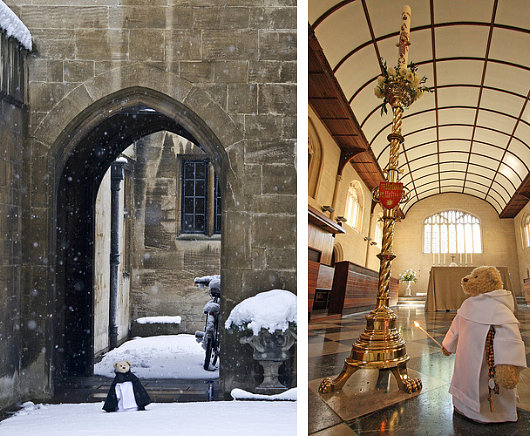
Left, contemplating the winter snow. Right, contemplating how the deuce a bear of his particular stature can light the Easter candle.
Chartres 2009
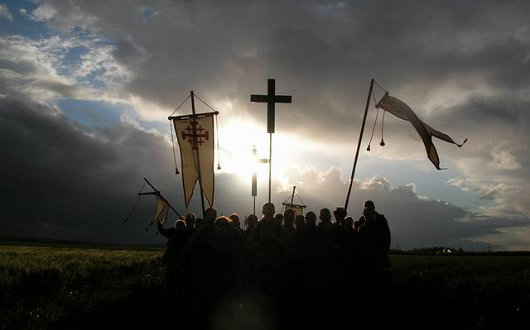
While there are but a few days to go, I can’t let this year depart without finally showing you photos of the 2009 Paris-Chartres pilgrimage which takes place every year on the weekend of Pentecost. (See 2008, 2005, 2004). The theme for the upcoming 28th Pilgrimage from Notre-Dame de Paris to Notre-Dame de Chartres was recently announced by the Association Notre-Dame de Chrétienté which organises the event. The 28th Pilgrimage will take place on the 22nd, 23rd, and 24th of May 2010, with the theme “The Church is Our Mother”. The themes for the individual days will be: 1) Teaching, under the patronage of St. Peter; 2) Sanctifying, under the patronage of St. Jean Vianney, the Curé d’Ars; 3) Governing, under the patronage of St. Pius X.
The following photos, however, are compiled from various sources, and show the pilgrimage which took place this past Pentecost. (more…)
The Oratory as It Was Built
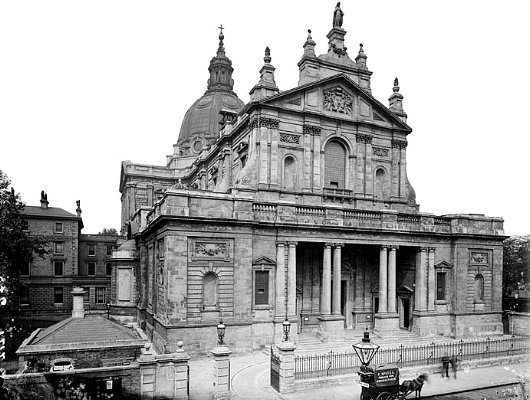
Since we explored Brompton Oratory as it might have been, here is the Oratory as it was built. The façade were finally completed in 1893 to a design by George Sherrin, with the dome following in 1894-95 by Sherrin’s assistant E. A. Rickards. How is the Oratory as depicted above different from the Oratory today? The fence and gates were replaced with a curved design at some date unknown to me, perhaps in response to a road-widening scheme.
Baptizing the Tricolore
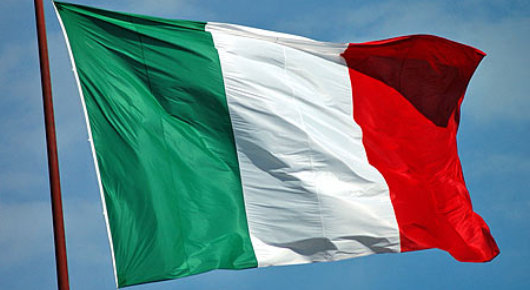
THE RECENT RULING of the self-styled “European Court of Human Rights” that the presence of crucifixes in Italian schools is a violation of the rights of a non-practicing Lutheran from Finland has sparked a surge of outrage against European institutions in Italy, and indeed elsewhere. While (as Gerald Warner has reported), the Italian Constitutional Court has shown the proverbial two fingers to the ECHR judgement in a ruling of its own, one junior cabinet minister has a suggestion of his own. Roberto Castelli, Italy’s deputy minister for infrastructure and transportation, suggests the country should reassert its Christian identity by adding a cross or crucifix to the Italian flag.
“I believe,” Mr. Castelli said, “that Europe has the right to recognize its true identity that we are starting to lose completely.” Even the Minister of Foreign Affairs, the Freemason and ex-Socialist Franco Frattini, seemed amenable to the idea. “Nine European countries already have the cross on their flag,” Frattini pointed out. “It is an extremely common proposition.” (more…)
Brompton Oratory as It Might Have Been
Failed Entries of the 1878 London Oratory Architectural Competition
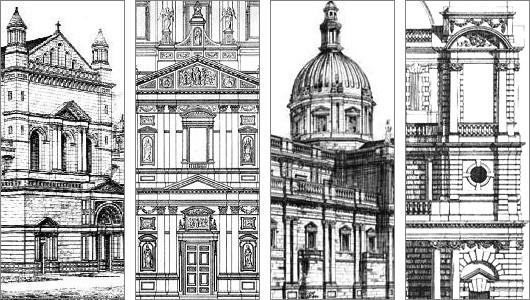
ARCHITECTURAL COMPETITIONS have always fascinated me because they give us the opportunity to glance at multiple executions for a single concept, to see different minds solve a “problem” with their own particular formulas and theorems. The designs of many of the world’s prominent buildings were chosen by competition, perhaps the Palace of Westminster — Britain’s Houses of Parliament — is most famous among them. When the Hungarian Parliament held a competition to design a grand palace to house the body, it found the top three prize designs so compelling that it built the first-prize design as parliament and the second and third places as government ministries nearby. To my surprise, I have only ever come across one book which adequately surveyed the subject of competitive architecture, Hilde de Haan’s Architects in Competition: International Architectural Competitions of the Last 200 Years. Most of the contests covered in the book are, naturally, for government buildings of national importance — private clients usually have a very firm idea of what they want and choose an architect accordingly.
One building not mentioned in the book but nonetheless very dear to me (and no doubt to many readers of this little corner of the web) is the Church of the Immaculate Heart of Mary of the Congregation of the London Oratory, more popularly known to friend and foe alike as the Brompton Oratory. It was the first church in Britain in which I ever heard mass, the summer after kindergarten when I was still but a tiny, blond-haired whippersnapper, in the midst of my first visit ever to the Old World, and the Oratory made quite a strong impression upon my young mind. It is usually one of my very first ports of call whenever I am in the capital, and I once even managed to slip in having just arrived at Heathrow while making my way to King’s Cross and the train to Scotland.
The Brompton Oratory is known for having good priests, traditional liturgy, and beautiful architecture. The final design was by one Herbert Gribble, but there was quite a bit of to-ing and fro-ing before Gribble was selected. The temporary church which had been erected on the site had been condemned by one critic as “almost contemptible” in its exterior design. In 1874, the Congregation of the Oratory (which is to say, the priests) put out an appeal for funds towards the construction of a permanent church. The 15th Duke of Norfolk obliged with £20,000 to get the ball rolling, and the next year a design by F. W. Moody and James Fergusson was agreed upon in principle. But the Reverend Fathers soon began to get creative and hatch ideas and contact other architects and very soon it was claimed that there were as many counter-proposals as there were priests of the Oratory, and perhaps more. A pack of clerics supported a suggested design by Herbert Gribble, but no accord could be reached among the Congregation as a whole.
In January 1878, then, it was announced that a competition would take place to decide the design of the permanent church of the London Oratorians. First prize was £200, with £75 for the runner-up. All entries had to meet the certain requirements drawn up by the Congregation. The style was to be “that of the Italian Renaissance”. The sanctuary, at least sixty feet deep, must be “the most important part of the Church. … Especially the altar and tabernacle should stand out as visibly the great object of the whole Church.” The minimum width of the nave was fifty feet, and maximum length 175 feet. Subsidiary chapels must be “distinct chambers”, not merely side altars. One aspect not mentioned was the projected execution costs of the designs — “an omission criticized by architectural journalists and disgruntled competitors,” the London Survey tells us, “whose designs called for expenditure ranging from £35,000 to £200,000”.
Over thirty entries were submitted to the competition, and Alfred Waterhouse was commissioned by the Fathers to provide comment on the submissions. Significantly, George Gilbert Scott, Jr. submitted a design, though I haven’t been able to get my hands on any depictions of it. Waterhouse praised it as “of no ordinary merit. … I feel that it is impossible to speak too highly of its beauty, its quiet dignity, its absence of all vulgarity and its concentration of effect around the high altar.” (more…)
Search
Instagram: @andcusack
Click here for my Instagram photos.Most Recent Posts
- Silver Jubilee November 21, 2024
- Articles of Note: 11 November 2024 November 11, 2024
- Why do you read? November 5, 2024
- India November 4, 2024
- The Lithe Efficiency of the Old Constitution November 4, 2024
Most Recent Comments
Book Wishlist
Monthly Archives
Categories


